‘We Will Be Priests’: Ordinations Continue Despite Coronavirus
What does it mean to become a priest at this time?
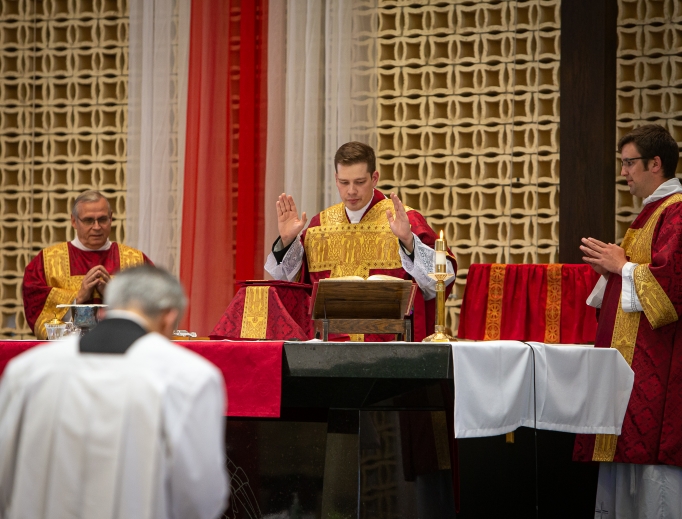
Through Christian persecutions, times of war, calamities of all sorts, and now the coronavirus, men continue to answer Christ’s call to his priesthood.
In dioceses throughout the country, although public Masses have been suspended since March and many are just now restoring access to the sacraments, albeit with strict guidelines, there was never a doubt that this year’s priestly ordinations would take place.
In many dioceses, plans for ordinations have not yet been finalized, but it appears that all will be livestreamed, which had already become customary. All celebrations have been scaled back, but in the end, this year’s crop of new priests will be added to the Church with all the zeal and excitement as any other year.
The “Ordination Class of 2020 Study” reveals that despite all the uncertainty caused by the coronavirus pandemic, the 448 identified members of this year’s class are enthusiastically looking forward to the priesthood. The annual survey is conducted by the U.S. Conference of Catholic Bishops (USCCB) Committee on Clergy, Consecrated Life and Vocations in conjunction with the Center for Applied Research in the Apostolate (CARA).
“At a moment when the faithful are prone to despair and struggle with the sadness of not having the sacraments available, and the public celebration of the Mass suspended, this profile of the 2020 Ordination Class is a ray of light,” the USCCB reported. “It is a tangible sign of God’s continued care for His Church … of the members of the current year’s Ordination Class. Each of the men to be ordained in the coming months shows the loving work of God to sustain his Church through the calling of new priests to minister His saving Sacraments and preach the Good News.”
The Journey to Ordination
“It was never really just about the day,” transitional Deacon Peter Grodi stated in an interview with the Register. “I did not prepare for ordination day; I planned for the priesthood — entering a new state of life and receiving the grace in a unique ministry. The day will be exciting, but it will be about the rest of my priesthood.”
His ordination, along with three other men in his diocese, is scheduled for the morning of June 27 at Our Lady, Queen of the Most Holy Rosary Cathedral in Toledo, Ohio. On his limited guest list will be his mother, Marilyn, and father, Marcus, the moderator of EWTN’s The Journey Home. Deacon Grodi explained that, for a time, there had been some question as to whether the ordination would need to be strictly private. Even now, he said that everyone understands that all plans are subject to change.
Although Grodi does not have a large family, he will easily fill his allotment of guests with relatives and a few people from different points in his life, including childhood and his time at Franciscan University of Steubenville and St. Meinrad Seminary and School of Theology in Indiana. As many know, his father is a well-known convert who features other converts on his show. “I was baptized before my parents became Catholic, so we joke that I brought the rest of the family into the Church,” Deacon Grodi told the Register, adding that even his non-Catholic relatives are very supportive of his vocation.
Ordination at such a time as this does not concern him. “God knows what is going to happen and what he has prepared us for, and this is the time that God put me in,” he said. “Since the priesthood began, they have had their challenges. I’m just excited to be ordained; the circumstances are secondary. COVID has not dampened the excitement.”
The shutdown of activities actually created a unique opportunity for Deacon Grodi. Given that The Journey Home had to reschedule its guests for a later date, his dad invited him to share his journey to the priesthood. “Sitting across from my dad, I gave him my full, ongoing story and realized this is the deepest we’ve talked about it.” That program will be aired on EWTN on June 8 at 8pm Eastern.
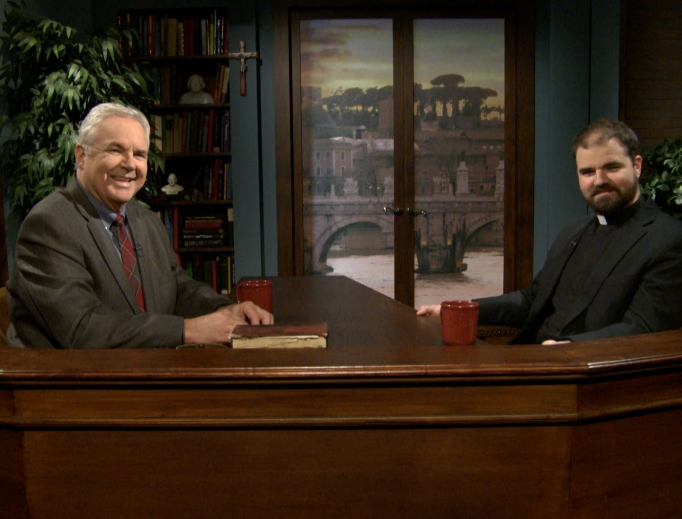
Transitional Deacon Peter Grodi and his father, Marcus, on the set of The Journey Home.
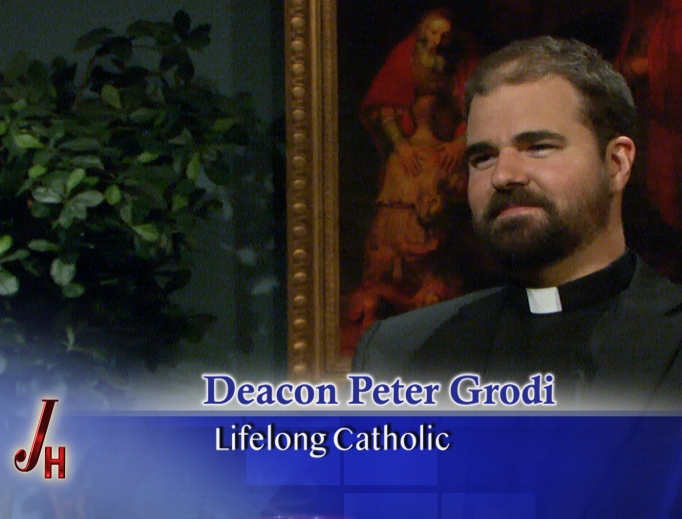
Deacon Grodi’s ordination will be livestreamed at ToledoPriesthood.org. “I encourage people to check with their diocese and support the priesthood that way,” he said. “It means a lot to support them by watching and to congratulate them.”
Challenge to a Governor
In the Archdiocese of St. Paul and Minneapolis, the ordination of five men from the diocese and two religious brothers out of Peru’s Proecalsia Sancta was scheduled for May 30 at the Cathedral of St. Paul, presided over by Archbishop Bernard Hebda. Gov. Tim Walz issued a new executive order permitting faith-based gatherings at 25% of church capacity, with a total limit of 250 people, beginning May 27. Before that, the governor had limited public worship to 10 people. The new order followed two days of meetings with Archbishop Hebda and other faith leaders, after Minnesota Catholic bishops announced on May 20 that they planned to move forward with Masses at 30% capacity. After the talks, the bishops agreed to modify their plans to 25% of capacity being allowed.
“Out of the discussion, we certainly always recognize legitimate authority and reasonable regulation, and while recognizing that it’s our responsibility to determine how it is that we regulate the liturgy, we think that’s a very reasonable regulation given the state of COVID-19 in our state,” Archbishop Hebda told The Catholic Spirit diocesan newspaper. The eleventh-hour change allowed each soon-to-be ordained priest to invite 25 guests.
According to Father David Blume, director of vocations, there were still many rules necessary to practice social distancing. Very few priests could be present, and attendance was by invitation only. Beautiful, sacred music was planned, but there was little or no congregational singing. Face masks were worn by the congregation, and Holy Communion was distributed in the hand with great care.
“For the sake of safety, it will be a small and beautiful gathering,” Father Blume said ahead of the ordination Mass. “The Church moves forward in good times and in bad. We have to figure out how to minister in the midst of the pandemic and keep lifting up Jesus. It’s not impossible, but it presents some challenges.”
Father Paul Hedman is among the five new archdiocesan priests. Before the new agreement was reached, the men to be ordained were asked if they would like to reschedule. “Unanimously, we said we wanted to keep the same date,” then-Deacon Hedman said before he was ordained a priest. He pointed out that St. John Vianney, the patron saint of parish priests, and Pope St. John Paul II, both had private ordinations. “It might be smaller, with less pomp and circumstance, but in the end, what matters is that we will be priests. We just want to start serving God’s people and saying Mass and hearing confessions.”
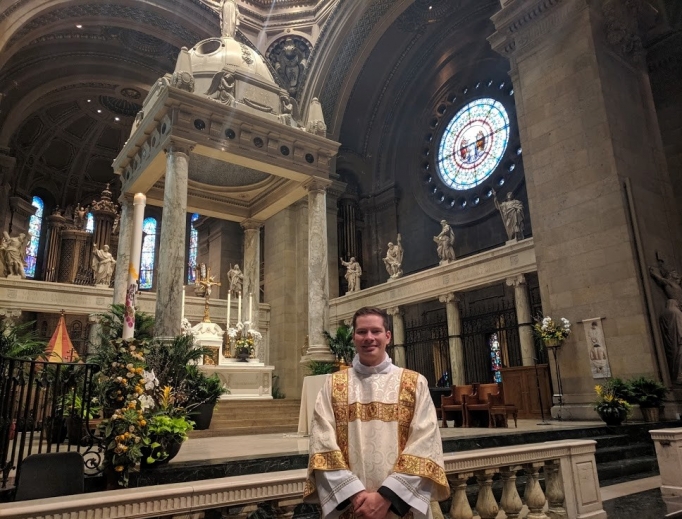
Father Paul Hedman at his diaconate Mass.
The usual post-ordination dinner and big family receptions were canceled, but ahead of the big day, then-Deacon Hedman was considering how he could adapt to the restrictions, such as having a drive-by reception. “Maybe I can give them some cake, a holy card and a blessing,” he said. “We have to think creatively during these times and be flexible.” He noted that each generation has its challenges. “This is our generation’s time to figure out how to bring the Lord to everyone. I think we will come out a stronger Church through it.”
Following his ordination to the priesthood, Father Hedman told the Register, “While the ordination was certainly much different than what I had always pictured it would be, it was still so incredibly grace-filled and beautiful. To be ordained a priest in these times shows the need for priests to listen to the hearts of Jesus’ people, which are so aching for him, and respond to that cry and be Christ to those in our world. A priest needs to offer himself as a victim, as Venerable Fulton Sheen said, and conform himself to Christ, most especially during these difficult times.”
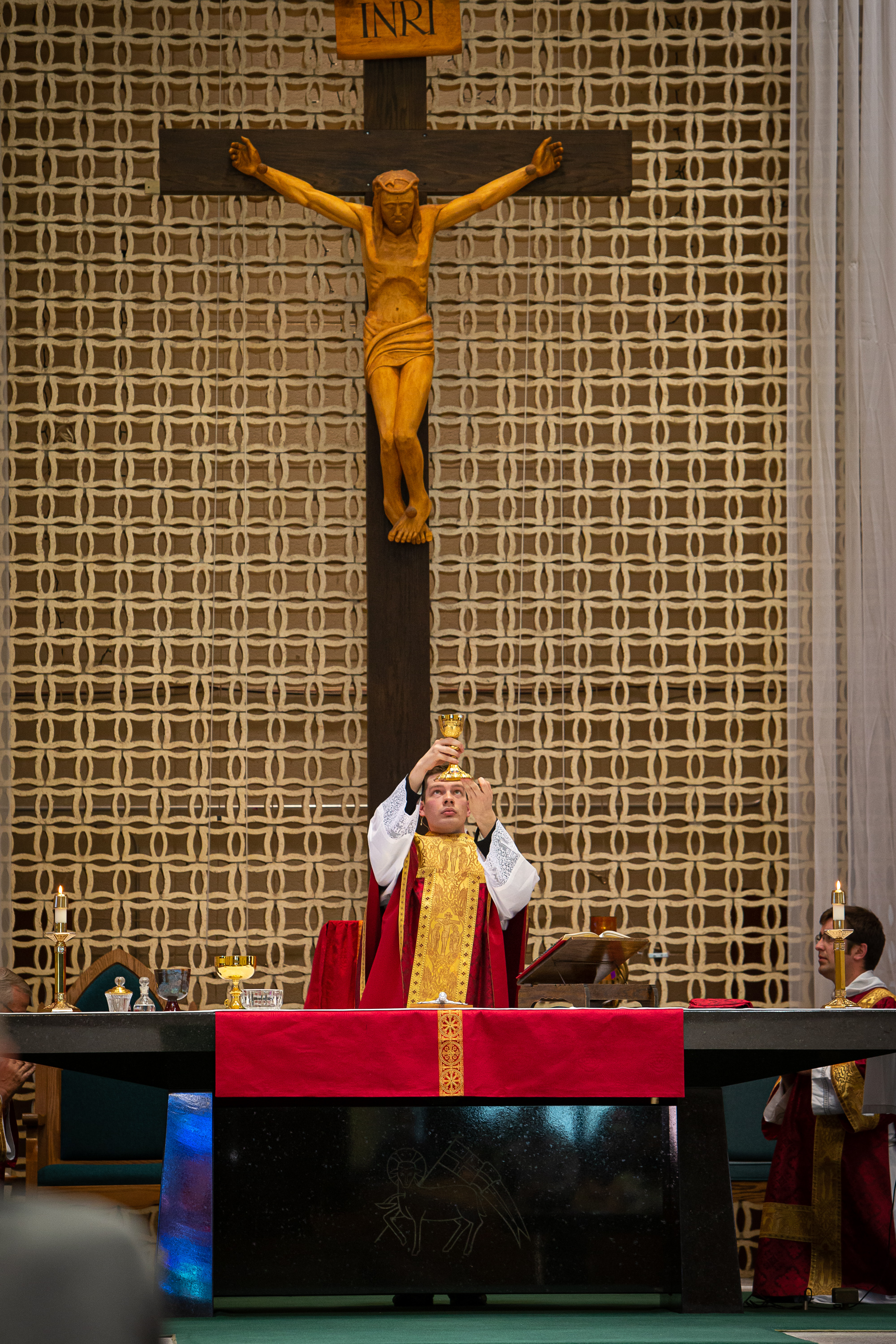
Father Hedman celebrates his first Mass on May 31.
A New Pentecost
Father Daniel Dozier was ordained on May 2, the feast of St. Athanasius of Alexandria, by Bishop John Pazak at St. Stephen Byzantine Catholic Cathedral in Phoenix. He has been assigned to serve at St. George the Great Martyr Byzantine Catholic Church and Our Lady of Perpetual Help Shrine in Olympia, Washington, where he had already been serving as the deacon administrator. As part of the Eastern Rite, he is able to be married before becoming a priest. He had served as a deacon for 12 years and has three children and one grandchild.
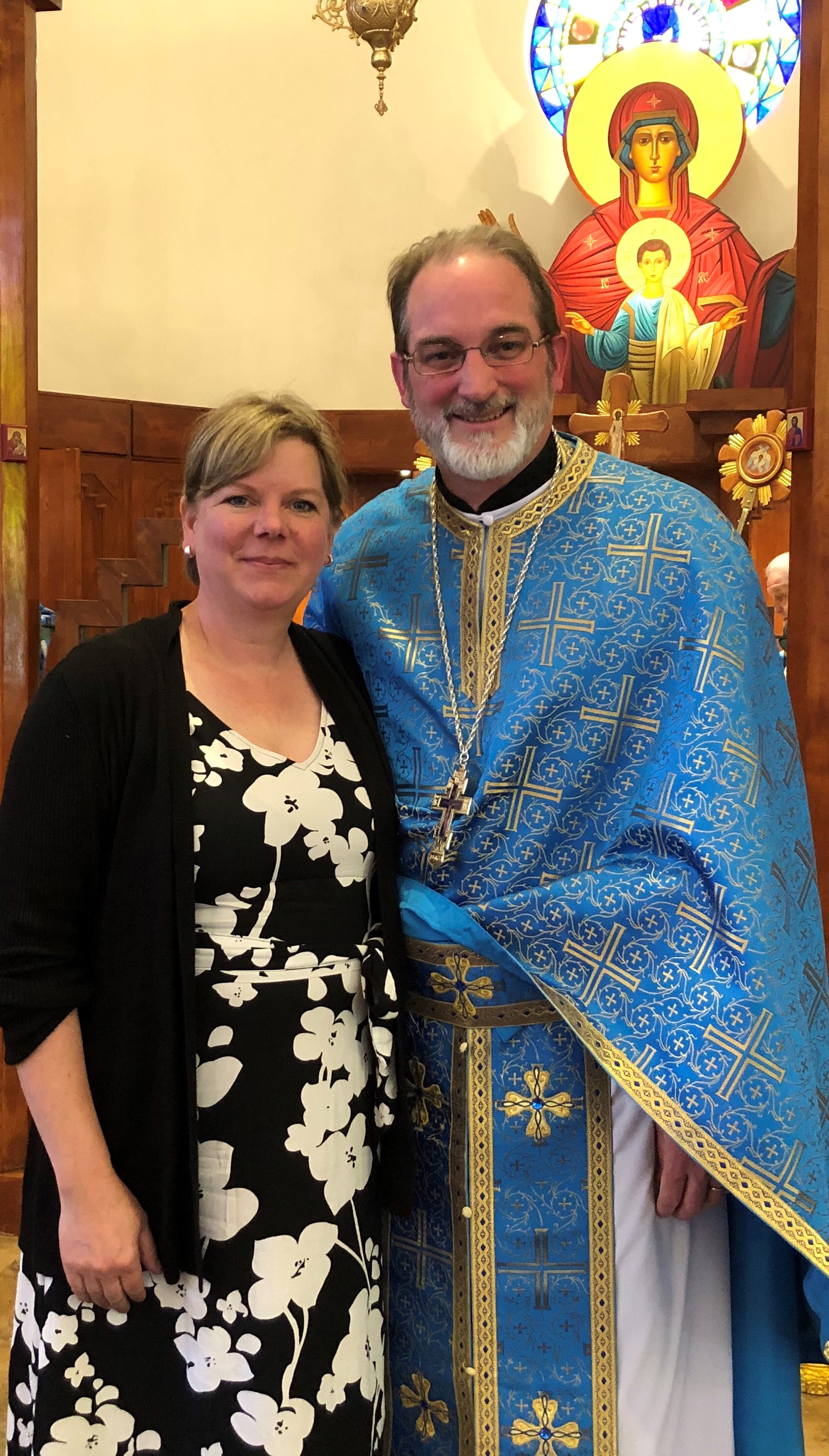
Byzantine Catholic Father Daniel Dozier with his wife, Pani Karen
“We had to limit ourselves to 10 people in the cathedral,” he said. “My wife was the only one who was able to attend, and my father (who is a Ukrainian Catholic deacon) and mother, along with my children, my seven siblings and in-laws had to watch via livestream.”
Father Dozier described every ordination as a new Pentecost for the whole Church and not just for the ordained.
“It is a fresh outpouring of the Holy Spirit that confirms and empowers us in our common life and mission,” he said. “I believe it to be a sign of enduring hope that God is blessing the Church with new priests and deacons, especially during this time.”
According to Father Dozier, their church community has found new and creative ways to pray together, to study the Scriptures and their faith, and to support each other amid the pandemic. “Two of our members permanently erected a cross in the front of the church during Holy Week in memory of those who have served and those who have suffered and died during this time,” Father Dozier said. “It was a place for people to come and to pray.” He plans to have the cross blessed by their bishop.
“I think we will look back on this time as providentially a great gift to the Church, to prepare us for a new springtime, much like the churches that emerged out of times of persecution or hardship,” Father Dozier said. “God is still with us!”
Patti Armstrong writes from North Dakota.
- Keywords:
- new priests
- ordinations
- patti armstrong
- priesthood


















